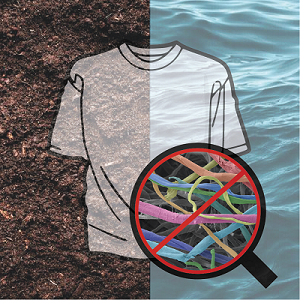STOP textile microplastic pollution
Discover our current research

- Faculty of Arts, Humanities and Cultures
- School of Design
- Research and innovation
STOP Textiles Microplastics Pollution
STOP textiles microplastics pollution project
Microplastics have been detected in all aquatic habitats, from deep oceans to polar icemelt and can be found in the guts and tissues of aquatic animals. More than one third of the microplastics found in the world oceans are fibrous microplastics from textiles. The fibrous microplastics are released throughout the lifecycle of a textile and their presence in aquatic and terrestrial environments is now well-established phenomena. The washing of textiles annual releases an estimated 0.5 million tonnes fibrous microplastics ocean pollution, which at current rates is expected to accumulate to 22 million tonnes by 2050.
Any remedial measures are challenging given the ubiquity of fibrous microplastics from textiles. Improved plastics with reduced environmental impact, plastic recycling and reduced consumption are extremely important but the release of fibrous microplastics from textiles remains a challenge. Here, we address this challenge by bringing together textile technology, computational modelling and tribology disciplines into a systematic programme of research. The overarching goal of this project is to experimentally and computationally elucidate fibre damage that leads to the generation of fibrous microplastics and use predictive computational modelling to inform the engineering of innovative textile structures which STOP the release of fibrous microplastics from textiles.

Funded by the Engineering and Physical Sciences Research Council, the STOP fibrous microplastic pollution from textiles by elucidating fibre damage and manufacturing novel textiles (EP/T024542/1) project aims to:
- create a fundamental understanding of the fibre damage (that leads to the generation of fibrous microplastics) and microstructural changes in textiles.
- build realistic and predictive computational wear models of the textile materials and open new avenues for research.
- develop industrially and commercially relevant solutions to STOP the release of fibrous microplastics from textiles.
The project team
- Dr Muhammad Tausif (Project Lead)
- Dr Ali Ghanbarzadeh (School of Mechanical Engineering)
- Dr Dongmin Yang
- Professor Chris Carr
- Dr Abdul Jabbar (PDRA)
Our project partners
- Gap Inc.
- The Microfibre Consortium
- Culimeta Saveguard Limited
News
As a part of this EPSRC project, Lab-scale Staple Yarn Spinning Line was installed at the School of Design, University of Leeds. The line can process small amount of natural, regenerated and synthetic fibres to produce yarns from both short and long fibres. This facility is pivotal to engineer bespoke yarns and subsequently textiles to meet the project outcomes.
<iframe width="560" height="315" src="https://www.youtube.com/embed/KaxH4Kg9-uc" title="YouTube video player" frameborder="0" allow="accelerometer; autoplay; clipboard-write; encrypted-media; gyroscope; picture-in-picture" allowfullscreen></iframe>
Contact
Dr Muhammad Tausif (Project Lead)
Associate Professor in Sustainable Textile Manufacturing
M.Tausif@leeds.ac.uk

